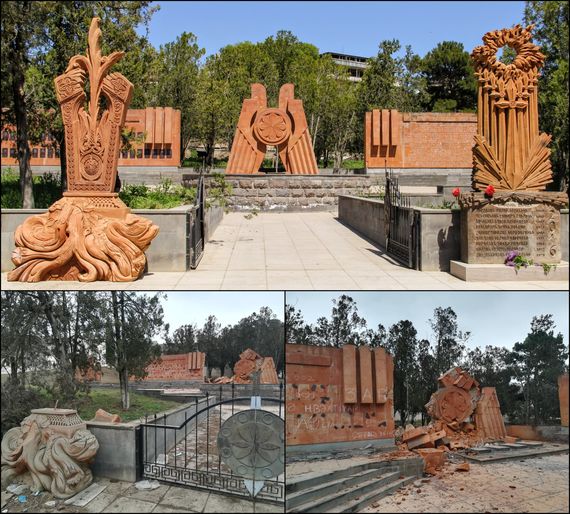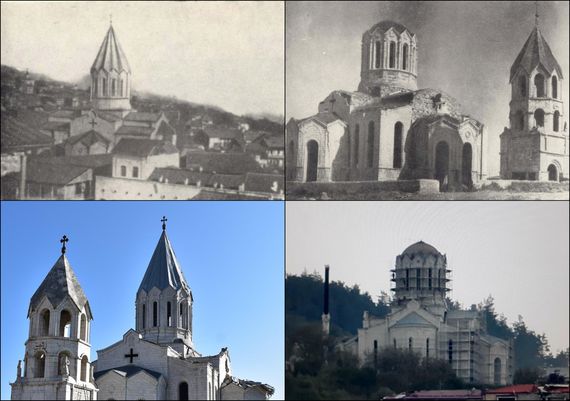
Illustration by Armine Shahbazyan.
Artsakh has almost four thousand historical and cultural monuments, including 241 chapels, churches and monasteries. Somewhere between 130 to 160 of those came under Azerbaijani control in the aftermath of the 2020 Artsakh War. As evident from these numbers alone, Artsakh has lost not just people, land and resources, but also a significant part of its indigenous Armenian cultural heritage. And that heritage is severely endangered. Azerbaijan, like Turkey, has long targeted Armenian monuments. The entire Armenian cultural presence in Nakhichevan has been entirely erased, including almost 90 medieval churches, 6,000 khachkars and over 20,000 tombstones that were documented in the late Soviet period.
Lost Heritage
Armenian monuments and sites currently under Azerbaijani control are under immediate threat of vandalism and destruction. In January Vahram Melikyan, the spokesperson of the Armenian Church, said that around 130 historic and recently-built churches and monasteries, and several thousand khachkars are now under Azerbaijani control. According to a detailed January 2021 report by the Artsakh Human Rights Defender’s office, 161 churches and monasteries have come under Azerbaijani control, including 56 in Hadrut, 42 in Karvachar (Kelbajar), 26 in Kashatagh, 13 in Askeran, 9 in Martakert, 9 in Martuni, and 6 in the Shushi district. The report listed 591 khachkars and 345 inscribed stones and tombstones, 43 fortresses, castles and palaces, among other cultural monuments and sites. Almost 20,000 exhibits in eight museums have also remained in Azerbaijani-controlled parts of Artsakh.
The single largest concentration of churches and monasteries is in the district of Hadrut, which was captured by Azerbaijan in October 2020. These include Gtchavank and Katarovank on top of Mount Dizapayt, and the ruined Okhte Drni Vank (Monastery of Seven Doors). Also in the same district are the Azokh Cave, where archaeologists have discovered Neanderthal remains, making it an important site in the study of human evolution, and the 18th century palace of Melik Yegan in the village of Togh. Elsewhere in Artsakh, important monuments that have come under Azerbaijani control include Tsitsernavank, just several kilometers outside the Lachin corridor, the monastery of Yeghishe Arakyal near Mataghis (Martakert), the hellenic and early Christian site of Tigranakert and the nearby church of Vankasar, Kusanats Anapat monastery in Kelbajar and the two standing churches of Shushi: Ghazanchetsots and Kanach Zham. The museums of Shushi were not evacuated and most of their exhibits are now under threat of erasure. Lusine Gharakhanyan, the Culture Minister of Artsakh, said the Azerbaijani capture of the town was “unexpected,” despite the fact that Artsakh President Arayik Harutyunyan publicly announced a week before the city fell that Azerbaijani forces are within just 5 km from Shushi.
Vandalism and Destruction: The Visual Evidence
Both during and after the war, the Azerbaijani military targeted a number of Armenian sites all over Artsakh. In January 2021, I compiled a list of instances of vandalism or destruction of around a dozen monuments based on the visual evidence available online to that date. It was likely not entirely reflective of the situation on the ground, as some other monuments could have been vandalized, damaged or destroyed without any evidence of those acts available online.
On October 3, 2020, a week into the war, archaeologist Hamlet Petrosyan, who has long led the excavations at the ancient city of Tigranakert, said that the site had already been shelled several times at that point. On November 6, two archaeological cottages were destroyed and two were damaged by Azerbaijan shelling.
On October 8, at the height of the war, Azerbaijan twice hit the iconic Ghazanchetsots Cathedral of Shushi with guided munitions, creating a large hole in the roof. In mid-November screenshots from a video showed the walls of the belltower of the cathedral covered in graffiti.
Another video that appeared online in mid-November showed Shushi’s Kanach Zham church without its dome and belltower. The circumstances of the damage are unknown, but a photo of an Azerbaijani soldier in front of the church points to its deliberate destruction after the town fell to Azerbaijani control. Satellite imagery from mid-February, available on Google Earth, shows and reconfirms the destruction of the belltower and dome of Kanach Zham.

The memorial complex in the village of Talish in 2017 (credit: Ashot Minasyan) and as it appeared after vandalism and destruction under Azerbaijani control in December 2020 (credit: Kirill Krivosheev)
In Shushi, the statue of Vazgen Sargsyan, Armenia’s Defense Minister during the First Karabakh War, was first spray painted while an Azerbaijani soldier sat on its head. Later photo and visual evidence showed the statue “beheaded.” More visual evidence of vandalism and destruction has emerged in recent months. Satellite images also show the destruction of a memorial in Shushi dedicated to the victims of the Armenian Genocide, fallen soldiers in World War II and the First Karabakh War. Also in March, a video was posted online of Azerbaijani soldiers pulling down the bust of Ivan Tevosyan, a Shushi-born Soviet official of Armenian origin, from its pedestal.
Elsewhere, Azerbaijani soldiers have heavily damaged memorials in Talish (in Martakert district), pulled down or vandalized khachkars in the village of Arakel (in Hadrut district), and the towns of Vorotan (Kubatli) and Mekhakavan (Jabrayil), and desecrated several cemeteries.
In Jabrayil, an Azerbaijani (or allied) soldier was recorded standing on top of a small Armenian church chanting “Allahu Akbar.” In March 2021, BBC correspondent Jonah Fisher documented the disappearance of that church, built in 2017, next to an Armenian military base. Its destruction is further confirmed by satellite imagery.
In late March, another video appeared online showing three Azerbaijani soldiers entering the late 19th century St. Yeghishe Church of Mataghis (not to be confused with the better known medieval monastery of St. Yeghishe, referred to as Jrvshtik), in the Martakert district. The church is vandalized and desecrated, with religious pictures and other items on the floor. A photo posted on social media showed what appears to be a war memorial, reportedly in the village of Aknaghbyur in the Askeran district, covered in red paint while an Azerbaijani soldier poses in front of it.
On May 5, Caucasus Heritage Watch, a research program initiated by Cornell and Purdue University professors, posted satellite images of an Armenian cemetery in the village of Mets Tagher in Hadrut that has been completely destroyed, while a mid-19th century church in the same village “appears to be threatened by construction.”
Ongoing Threats
Satellite imagery from mid-April showed a truck and other vehicles, along with a newly-built “temporary rectangular structure,” in the parking lot to the east of the church of Vankasar. Archaeologist Lori Khatchadourian said that “the purpose of this equipment is unclear, but it is concerning to see heavy machinery adjacent to a sacred site and just above the Tigranakert archaeological site.”
In late April 2021, a video posted online showed scaffolding installed around Shushi’s Ghazanchetsots Cathedral. Archaeologist Hamlet Petrosyan warned that Azerbaijan intends to “distort” the cathedral and possibly remove its Armenian inscriptions. Propagandists of the Aliyev regime posted more photos of Ghazanchetsots surrounded by scaffolding and boasted about restoring the church.

Shushi’s Ghazanchetsots in 1904 and 1975 (source: Shahen Mkrtchyan, Historical-Architectural Monuments of Nagorno-Karabakh, 1980); the church after it was hit twice by the Azerbaijani military on October 8, 2020 (credit: hetq.am); the cathedral without the metal roof on its iconic dome on May 4, 2021 (source: Gegham Stepanyan)
In early May, a photo of the church from Armenian-controlled territory showed Ghazanchetsots without the metal conical roof on its dome. Gegham Stepanyan, the Human Rights Defender of Artsakh, argued that Azerbaijan is distorting the church under the guise of restoration. In the past, Azerbaijani propagandists have promoted the baseless claim that the church is, in reality, Russian Orthodox and originally had a typical Orthodox-style circular roof. This absurd claim has been more widely applied to Kanach Zham church as well. Azerbaijan’s MFA claimed that the restoration of “Gazanchi Church” is “carried out in accordance with the original architectural style in order to restore the historical image of Shusha.” An Azerbaijani government source told Caucasian Knot that their aim is to “restore” the “original appearance” of the church, namely removing the pointed dome, which he claimed did not exist before. Historical photographs from over a century ago, however, clearly show its typical Armenian-style conical dome.
Cultural Cleansing
Armenophobia has been at the core of the Aliyev regime’s state-driven propaganda since the 1990s. Everything Armenian is labeled either “Albanian” or “fake.” During the war, when asked about the double strike on Ghazanchetsots Cathedral, Aliyev responded he was “not sure about what happened. We have doubts that that could have been done by Armenians in order to blame us.” In another interview, he simply downplayed it as “very minor damage.” Azerbaijan’s state-owned AzerTac news agency blamed the Armenian side for the strikes on the church.
The rhetoric was emboldened by the victory on the battlefield. In mid-March, Aliyev visited the village of Tsakuri (Hünərli), in Hadrut district, where he proclaimed the Armenian inscriptions on the 12th century monastery of Tsaghkavank to be “Albanian” and claimed they were “Armenianized” later. Aliyev’s adviser Hikmet Hajiyev tweeted in March that “Falsified mythic story about [sic] tigranakert is over.”
Furthermore, Azerbaijan has effectively banned UNESCO experts and representatives from visiting the region. On November 18, UNESCO Director-General Audrey Azoulay proposed Armenia and Azerbaijan to send the “technical support of UNESCO … [to] carry out a preliminary field mission, in order to draw up an inventory of the most significant cultural assets, as a prerequisite for effective protection of the region's heritage.” A month later, Ernesto Ottone, Assistant UNESCO Director-General for Culture, stated that the organization is still waiting for Azerbaijan’s response. “The authorities of Azerbaijan have been approached several times without success so far. [...] The window of opportunity that was opened by the cease fire must not be closed again,” read the statement. Azerbaijan’s MFA responded that “Azerbaijan is [still] considering the proposal” and blamed UNESCO for ignoring their own pleas, for 30 years, to investigate “war crimes such as destruction, misappropriation of our cultural heritage” by Armenians.
The Russian Role
Russia, and President Vladimir Putin personally, have emphasized the importance of the preservation of historical sites in the war zone. Ten days after the armistice agreement, Putin told other top officials that the "need to protect historical and religious landmarks, both in Azerbaijan and Armenia,” is “of great moral and human importance.” Without naming Dadivank, he said that “one of the oldest Christian monasteries” should be accessible for both Armenians and Azerbaijanis. Several days later, Putin told Turkish President Erdogan that “problems linked with … [the] preservation of religious and cultural sites must be resolved without delay.” During his January 2021 speech at the World Economic Forum, Putin again mentioned “protecting and restoring historical, religious and cultural landmarks” as one of the challenges of the Karabakh conflict.
Immediately after the November 9 ceasefire agreement, Dadivank, one of the better-known monasteries of Artsakh, was reported to be handed over to Azerbaijan as it is located just inside the Kelbajar district, which was to be handed over to Azerbaijan by November 15. However, it was announced by the Armenian Church on November 14 that Dadivank would be put under the effective control of Russian peacekeepers, who were deployed at the monastery the next day. Vahram Melikyan, the Armenian Church spokesperson, later revealed that Patriarch Kirill, the head of the Russian Orthodox Church, personally intervened to safeguard Dadivank, while President Putin instructed Russian peacekeepers to be deployed to the area. Though Azerbaijan has tried to push its “Caucasian Albanian” narrative on Dadivank by dispatching a loyal Udi priest in early December, Dadivank remains Armenian with six Armenian clergy serving there as of December. Armenian pilgrims regularly visit Dadivank, while at least one wedding has taken place there since the end of the war. Russia’s Defense Ministry regularly posts videos of Russian convoys escorting Armenian pilgrims to the monastery. But at least on one occasion, in February 2021, Armenian pilgrims were prevented by Azerbaijani forces from visiting Dadivank.
Amaras, another important monastery of Artsakh, is under Armenian control, but Russian peacekeepers have established their presence on its premises and regularly escort the convoys of Armenian pilgrims visiting the monastery. In the weeks after the war, there was much confusion about which side of the new border Amaras was in. It was not until two weeks after the armistice agreement that a crew of local journalists visited Amaras, which showed it to be under the control of Armenian forces, albeit the Russian flag was raised over it. It was later revealed that Amaras is now located less than a kilometer from the new line of contact. On April 4, when the Armenian Church celebrated Easter, Artsakh President Arayik Harutyunyan visited the monastery with a large group of pilgrims and the official video showed the flag of Artsakh raised over the monastery. During April, the Russian peacekeeping mission escorted Armenian pilgrims to Amaras on at least three occasions.
Comments
Paul Noroian
6/19/2021, 9:42:32 PMDear Hovhannes Nazaretyan, I appreciate your work. I had been acquainted with the late Samvel Karapetyan, who did so much to document Armenia cultural monuments in Georgia and Karabakh. I just finished reading your article about Stephan Shaumyan and it is even more relevant in the current situation. Please don't despair. You will help steer Armenia in the right direction.




